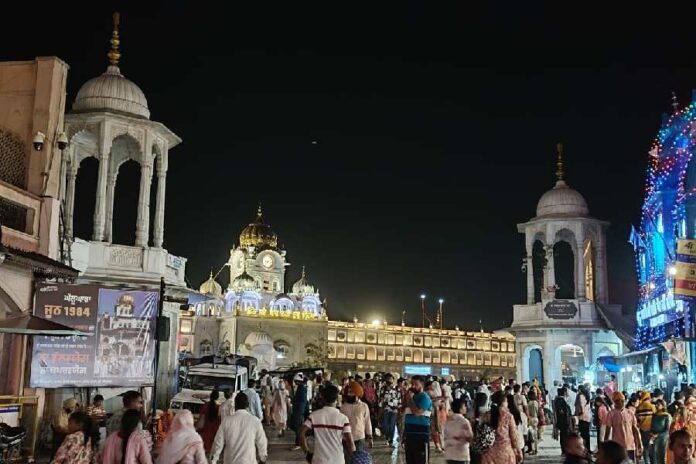India’s brutal ‘Operation Blue Star’ was the military operation which occurred between 3–8 June 1984, ordered by the then Prime Minister Indira Gandhi to get control over the Golden Temple complex (Harmandir Sahid), the holiest shrine of the Sikhs in Amritsar, Punjab, and to arrest Sikhs’ spiritual leader Jarnail Singh Bhindranwale, including his followers from the complex buildings. Bhindranwale had earlier taken residence in the Harmandir Sahib. He was the only leader who had boldly been fighting for the genuine rights of the Sikhs.
The Indian Army led by General Kuldip Singh Brar, supported by troops and armoured vehicles, broke all records of state terrorism and extrajudicial killings through that barbaric operation. In those days, the majority of the Sikhs were coming to the temple complex to celebrate the Martyr Day of Guru Arjun Dev.
The Indian forces used tanks and destroyed the Akaal Takht Sahib which is right in front of the Harmandir Sahib. On June 6, when all Sikh fighters were martyred along with Bhindranwale, Indian troops entered the temple complex with their shoes, deliberately ignoring the holiness of the place. When the Indian Army felt that only 251 men had prevented them from entering the Golden Temple for so many days, they started killing innocent Sikhs who had come there to visit the temple. The only purpose was to hide their humiliation.
In this regard, in their book: The Sikh Struggle, Ramnarain Kumar and George Sieberer write: “The army killed every Sikh who could be found inside the temple-complex. They were hauled out of rooms, brought to corridors on the circumference of the temple and with their hands tied behind their back, were shot in cold blood. Among the victims were many old men, women and children….all visitors were locked up in rooms for two days without any food, water, or electricity and were starved to death. Besides, the Harmandir Sahib remained under the army control for many months.”
The brutality of the ‘Operation Blue Star’ was not confined to the Harmandir Sahib. Indian armed forces simultaneously attacked 40 other historic gurdwaras all over East Punjab. When Sikhs in other states came to know about the desecration of the Golden Temple and the massacre of their brethren, they quickly left for Punjab. New Delhi tried to stop them before they could reach Punjab. Many Sikhs were murdered on the way.
According to an estimate, about 50,000 Sikhs were killed within a few days. The whole of Amritsar city was sealed and was burnt. A number of tourists either were murdered or arrested. Shops belonging to Sikhs were looted and their houses were set ablaze by Hindu mobs. In most of the cases, Sikh women were molested and some persons of their community were also burnt. Besides, historical Sikh artifacts as well as all the literature written by the gurus were also set ablaze by the Indian army.
In the same year of November, two dedicated Sikhs named Beant Singh and Satwant Singh, policemen who were posted at Prime Minister Indira Gandhi’s residence in New Delhi, assassinated her. Then Hindu riots erupted in the capital and other cities in which more than 15,000 Sikhs were murdered, while police watched silently so as to provide the Hindus with a free hand to massacre Sikhs.After the ‘Operation Blue Star’, the Sikhs’ struggle for independence continued, but the Indian government made every effort to crush it with the state machinery. To maintain its control over the Harmandir Sahib, another attack was launched on the Temple in 1987, called ‘Operation Black Thunder’.
This time only Sikh resistance, which was the natural outcome of the tragedy, was the main target. In that respect, quite a number of people of their community were killed and dead bodies lay inside the sacred place for many days.
A report disclosed that many trucks were loaded with dead bodies and all were burned with kerosene oil. Afterwards, ‘Operation Woodrose’ and ‘Operation Black Thunder-II’ were conducted against the Sikh community, which also assassinated them extrajudicially. After these barbaric operations, Sikhs organised themselves into an armed power in order to fight the Indian state terrorism. Many Sikhs left India to escape further genocide. Sikhs have spread out all over the world to keep the movement of Khalistan alive. In this connection, their struggle is still going on.
In fact, after the brutal operation Blue Star, the international community had thought that perhaps Sikhs have become lethargic regarding their demand for an independent state in the Indian Punjab, named Khalistan.
But, participation of almost 208,000 Sikhs in the Khalistan referendums held in the recent years in four western countries—the huge number of Sikhs who voted in favour of an independent Khalistan reflected that their demand is gradually being accepted globally.
On March 18, 2023, prior to the launching of crackdown by the Indian police and paramilitary forces, section-144 was imposed, and mobile phone service was suspended in Sri Muktsar Sahib and Fazilka districts of the Indian Punjab.
Ever since Amritpal Singh Sandhu took over as the head of ‘Waris Punjab De’ after the death of its founder head named Deep Sidhu, state machinery started harassing him by cancelling arms licences of his guards and detaining his friends. Police arrested a large number of Sikhs including members of ‘Waris Punjab De’ and Amritpal Singh.
Sikh freedom followers, their various organizations, especially the World Sikh Organization of Canada (WSO) as well as their leaders condemned the security operations—expressed serious concerns over the crackdown, an internet blackout throughout the state of Punjab—draconian measures, extrajudicial killings, harassment of the Sikh population, suspension of civil liberties and arrest of Sikh leader, Bhai Amritpal Singh.
Meanwhile, Sikhs had taken to streets in London and gathered at Indian High Commission to deliver the note of protest to Indian envoy. Thus, one of the enraged Sikh pulled down Indian flag and replaced it with that of Khalistan. In this respect, Modi had spoken to British Prime Minister Rishi Sunak—the Indian authorities called on the UK government to monitor groups like Sikhs For Justice (SFJ) who have been blamed by New Delhi for mobilising and radicalising thousands of Sikhs through Khalistan referendums.
And EU Sikhs had held an anti-India protest demonstration in front of the Brussels Parliament in Brussels on March 27, 2023, calling on European Commission to challenge India’s massive security crackdown.Similarly, the California state assembly passed a resolution on April 10, last year, which said that the Sikh community in the US had not yet recovered from the physical and psychological trauma of the riots, urging the US Congress to formally recognise the 1984 anti-Sikh riots in India as ‘genocide’, and to condemn the violence.
Tim S. Uppal Canadian Conservative Party deputy leader, Gurratan Singh, former Member of the Provincial Parliament, Author and poet Rupi Kaur as well as renowned Sikh persons living in Canada expressed serious concerns over crackdown against Sikhs in India-gross human rights violations.
It is notable that ‘Khalistan Zindabad’ slogans were raised on the occasion of Khalsa Day festivities on April 28, this year in Toronto when Canadian Prime Minister Justin Trudeau addressed the Sikh community, assured “nearly 800 thousand Canadians of Sikh heritage” that his government will always be there to protect their rights and freedom.
Very tensions accelerated between Canada and India on September 18, 2023 when Canadian Prime Minister Trudeau stated that Canada was investigating “credible allegations” linking India to the June killing of Canadian citizen and prominent Sikh leader, Hardeep Singh Nijjar. Canada also kicked out an Indian diplomat whom foreign affairs minister Mélanie Joly described presence of the head of the Indian intelligence agency in the country. In response, India expelled a senior Canadian diplomat based in India.
Notably, the leading Canadian Sikh leader of the Khalistan’s movement Nijjar was killed on June 18, 2023. According to local police, he was gunned down in his truck by two masked gunmen outside a Sikh temple in Surrey, British Columbia. The foremost pro-Khalistan’s separatist group SFJ—General Counsel Gurpatwant Singh Pannun had condemned the killing of SFJ’s Canada leader Nijjar.
He has disclosed: “Indian intelligence agency Research and Analysis Wing (RAW), acting under the instructions of PM Narendra Modi—his close associates Amit Shah and Ajit Doval assassinated Hardeep Singh Nijjar—the incharge of Khalistan Referendum in Canada”. The US and some of its allies urged India to cooperate with Canada on Sikh leader’s murder probe.
The Washington Post on April 30, this year reported: “an officer in India’s intelligence service was directly involved in a foiled plan to assassinate a citizen of the United States, who is a vocal critic of Indian Prime Minister Modi”—the RAW officer was also involved in the assassination of a Sikh activist last June in Canada.
A day later, the Australian Broadcasting Corporation (ABC) published another report, saying a nest of Indian spies was uncovered and expelled from the country for trying to steal defence secrets. Nonetheless, the Sikhs are fighting for a separate homeland since 1947, but the movement gained impetus by the efforts of Sant Jarnail Singh Bhindranwale who was killed by Indian Army in 1984.























